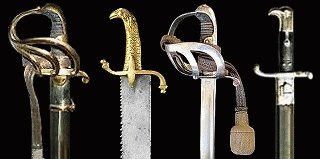28.11.07, 01:10:56
ulfberth
geändert von: ulfberth - 28.11.07, 08:35:42
Preussisk Forsøgssabel for let Kavalerie
In der dänischen „VabenHistorisk Tidsskrift“ Nr. 7 von 1993 wird eine Variante des preussischen (Versuchs-?) Säbels von 1849 beschrieben. Hier befindet sich abweichend eine Fingerschlaufen-Öse am Griffring. Autor des Beitrags ist Erik Troldhuus, von dem ich seinerzeit auch das hier abgebildete Foto erhielt.
Siehe hierzu auch den „Säbel der Garde-Husaren“ bei
militaria.web
Gruß
ulfberth
28.11.07, 11:00:16
ulfberth
geändert von: ulfberth - 28.11.07, 12:14:59
Es ist mehr als interessant, Informationen zu dem fraglichen Säbel auch aus dänischer Sicht zu bekommen. Ich kann das Heft nur jedem am Thema interessierten empfehlen.
Die komplette Textwiedergabe mit Bildern müßte erst mit dem Autor oder der Zeitschrift abgeklärt werden.
Erik Troldhuus publiziert in seinem Beitrag auch eine englische Kurzfassung, die ich hier nicht vorenthalten möchte:
"EXPERIMENTA1 SABRE FOR THE PRUSSIAN LIGHT CAVALRY
Mid 19th Century the Prussian Cavalry was still equip-ped with the socalled "Blucher-sabre" P. 1811. It had a simple stirrup hilt, which offered little protection for the hand, when used in combat. Some attempts were made to improve it by screwing on some bars, but it did not work. After a battle in July 1848 with Danish Dragoons a Prussian trooper Complained in a letter about his sabre. Three of his comrades had had their fingers cut and knockles wounded in the battle due to lack of proper hand protection. Much to the envy of their opponents Danish troopers carried a basket hiked sabre (P. 1843), which proved very successful.
Due to serveral complaints about cavalry sabres the Prussian War Department decided to carry out certain trials with a new type of sabre, which resembled the Bliicher with the extra bars, but was a completely new design. Until recently this sabre was unknown to German collectors and historians. The unidentified specimen shown here was found in a Danish collection. The crowned FW immediately pointed in the direction of Prussia (Frederick Wilhelm IV, 1840-61) and it has now been established that this type of sabre was issued to a whole regiment of Prussian Hussars probably as early as 1848. One would have found it obvious to try these sabres in real combat, e.g. against the Danes during the Schleswig-Holstein uprising i 1848-49-50. This may also have happened and thus explains the presence of the sabre here in Danmark. Again the trials were not successful enough to convince the War Department. However, it most likely led to the design of the well known Prussian Light Cavalry Sabre P. 1852. Eventually the batch of experimental sabres was abolished and sold to England, who made fine use of them in the Crimean War (1853-56).
Thanks are due to Mr. Rolf Selzer and Mr. Peter Meihs, Germany, for information included in this article."
Gruß
ulfberth
06.11.24, 20:30:50
fritz1888
Bitte um Nachricht falls jemand noch solch einen Säbel sucht. Danke.
07.11.24, 08:01:48
corrado26
Die komplette Textwiedergabe mit Bildern müßte erst mit dem Autor ..... abgeklärt werden.
Dürfte schwierig werden: Erik Troldhuus ist bereits vor längerer Zeit gestorben

